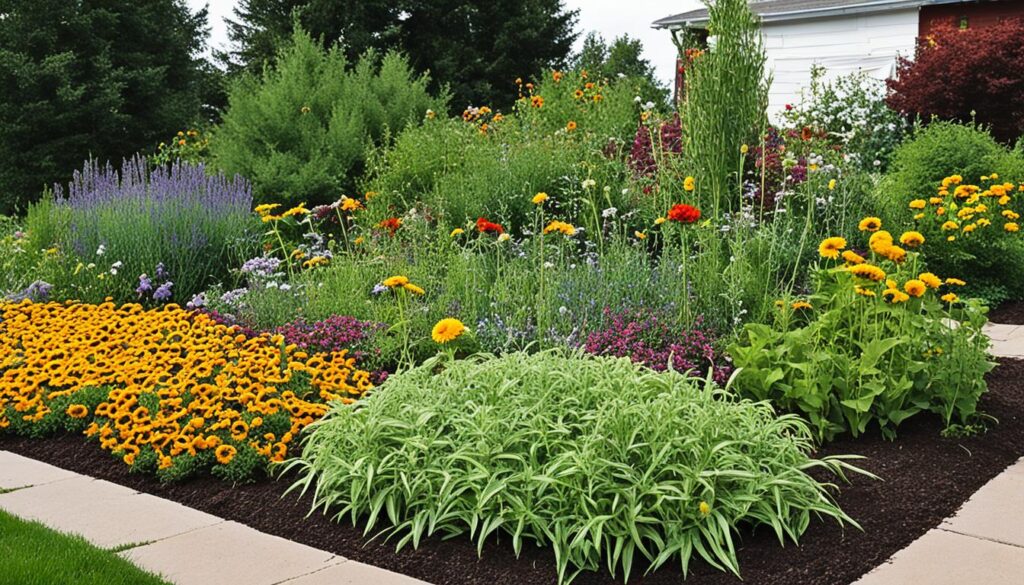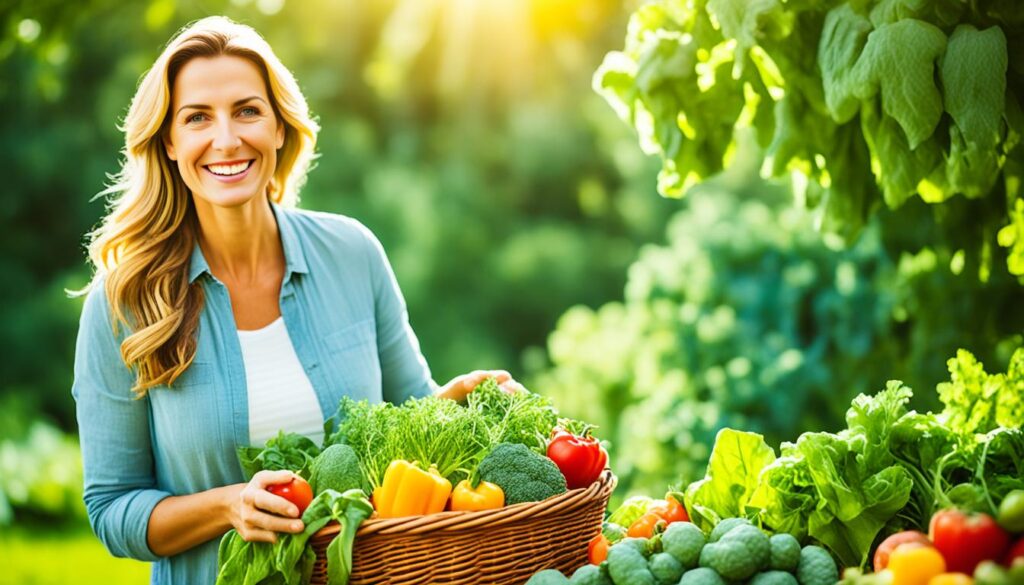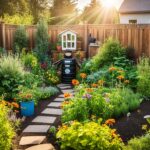40. Best Practices for Managing a Sustainable Garden Year-Round
Imagine a garden that grows well without using up too many resources or hurting the planet. With the right sustainable gardening tips, you can make your garden a self-sustaining place. It will need little upkeep and help you garden more efficiently. But, where do you begin? How can you keep your garden looking great all year?
This guide will show you the best ways to manage a sustainable garden all year. You’ll learn about planning, planting, controlling pests, and preserving your garden. Discover how to create an eco-friendly garden that feeds your family and helps the environment. Get ready to learn the secrets of sustainable gardening and see your garden flourish like never before.
Key Takeaways
- Use sustainable gardening methods to lessen your environmental impact and improve soil health.
- Plan your garden with native, diverse plants that support local ecosystems and need fewer resources.
- Use water wisely and compost to cut down on waste and increase efficiency.
- Control pests and weeds naturally, avoiding harmful chemicals and boosting biodiversity.
- Buy your gardening supplies locally to support your community and lower transportation emissions.
Benefits of Sustainable Gardening
Sustainable gardening is more than just growing plants. It helps the environment and makes your garden healthier. By using eco-friendly methods, you can lessen your impact on the planet and boost your plants’ health.
Reducing Environmental Impact
By gardening sustainably, you can cut down on your carbon footprint and save natural resources. Composting turns waste into food for your soil, keeping it rich and fertile. Using less water and choosing plants that don’t need much water also helps save this vital resource.
Choosing not to use harmful chemicals keeps your garden and the environment safe. This creates a better place for all living things.
Improving Soil Health
Healthy soil is key in sustainable gardens. Adding compost and cover crops makes your soil better for your plants. This leads to stronger, healthier plants that can handle your local weather.
Healthy soil also means more good bugs and worms, which helps your garden cycle nutrients naturally. This makes your garden a better place for plants to grow.
| Sustainable Gardening Benefit | Impact |
|---|---|
| Reduced Environmental Impact |
|
| Improved Soil Health |
|
“Sustainable gardening is not just about growing plants – it’s about nurturing the entire ecosystem, from the soil to the wildlife that call your garden home.”
Planning Your Sustainable Garden
Starting a sustainable garden means planning carefully. First, think about what you want from your garden. Do you want to grow food, help pollinators, or make a beautiful space? After deciding, pick a variety of native plants that fit your local climate and soil.
Defining Your Gardening Goals
Think about what you want from your garden. Do you aim to grow your own food or help local wildlife? Knowing your gardening goals helps pick the right plants and designs.
Choosing Native and Diverse Plants
Native plants are perfect for your area because they need less water and food. Using many native plants makes your garden strong and full of life. Think about your garden’s sunlight and soil to pick the best plants.
“Sustainable gardening is not just about the plants you choose, but the entire ecosystem you create. By focusing on native species and promoting biodiversity, you’ll witness your garden come alive with vibrant colors, buzzing insects, and joyful birdsong.”
Garden planning and sustainable garden design work together. Set your goals and choose the right native plants for a beautiful, eco-friendly garden.
Sustainable Gardening Techniques
Sustainable gardening is all about making your garden better for the planet and for you. It’s about composting and saving water. These two things are key for a green garden.
Composting Organic Waste
Composting is a big deal in sustainable gardening. You turn food scraps, yard clippings, and leaves into soil that feeds your plants. It cuts down on landfill waste and makes soil healthier. This means your plants grow better and you use fewer chemicals.
Water Conservation Methods
Water is precious, and saving it is important in gardening. Using rain barrels and mulch helps you use less water. Watering in the cool hours also helps. These methods keep water around for your plants and protect our environment.
| Sustainable Gardening Technique | Benefits |
|---|---|
| Composting Organic Waste |
|
| Water Conservation Methods |
|
Using these sustainable gardening tips, you can make a garden that’s good for the earth and for you. It’s a win-win for everyone.
Managing Pests and Weeds Naturally
As a sustainable gardener, you aim to make a garden that works with nature. You look into natural pest control and organic weed management instead of harsh chemicals. Using eco-friendly gardening methods helps keep your garden healthy and your food safe.
One good way to control pests and weeds is with physical barriers. Use row covers or mesh to keep pests away from your plants. These barriers let air, light, and water in but keep pests out. You can also bring in ladybugs, which eat many garden pests.
For weeds, try organic mulches to stop them from growing. Mulch blocks sunlight and stops weed seeds from sprouting. Pulling weeds by hand is another great way to keep your garden clean.
| Natural Pest Control Methods | Organic Weed Management Techniques |
|---|---|
|
|
Using these natural pest control and organic weed management methods makes a garden that’s good for the environment. Your plants will be healthier, your soil richer, and your harvest will be safe and plentiful.

Sourcing Supplies Locally
When planning your sustainable garden, think about getting your supplies from local places. Buying plants, seeds, and other items from nearby nurseries, garden centers, and farmers’ markets helps your community. It also cuts down on the harm caused by transporting goods over long distances.
Supporting Local Growers
Local plants fit well with your area’s weather and soil, making them more likely to thrive in your garden. Buying from local spots also boosts your community’s economy. It encourages gardening that is good for the planet.
Reducing Transportation Emissions
Getting your gardening stuff closer to home means less carbon emissions from transport. This is key to sustainable gardening. It helps make your garden’s impact on the environment smaller.
| Benefit | Description |
|---|---|
| Adapt to local conditions | Plants sourced locally are often better suited to your region’s climate and soil, leading to higher success rates. |
| Support community growers | Purchasing from local nurseries and farmers’ markets helps to strengthen your community’s economy and promote sustainable gardening. |
| Reduce emissions | Minimizing the transportation distance of your gardening supplies lowers the carbon footprint associated with their delivery. |
Trying to get your garden supplies from local places makes your gardening more sustainable. It helps your community and cuts down on carbon emissions from transport. This is good for the planet and supports eco-friendly gardening.
Encouraging Biodiversity
Sustainable gardening means creating a thriving ecosystem in your yard. By encouraging biodiversity, you draw in helpful insects and animals. These creatures help control pests and support your eco-friendly gardening goals.
Attracting Beneficial Insects and Wildlife
To attract beneficial insects, plant native flowers, herbs, and shrubs. These plants offer food and shelter to local wildlife. Also, leave some areas wild to support diverse habitats.
Creating Habitats for Native Species
Creating wildlife habitats helps the local ecosystem and lets you watch the wildlife up close. Provide nesting sites for birds and leave leaves and branches for small mammals. This sustainable landscaping makes your garden a haven for many species.
“A garden is a grand teacher. It teaches patience and careful watchfulness; it teaches industry and thrift; above all it teaches entire trust.” – Gertrude Jekyll
Year-Round Sustainable Gardening
Sustainable gardening is a year-round effort. It’s about keeping your garden healthy, productive, and good for the planet. Using crop rotation and succession planting helps your garden work better and cuts down on the need for extra help.
Crop Rotation and Succession Planting
Move your vegetable crops around the garden each year to stop diseases and pests. This crop rotation keeps the soil healthy and breaks up the life cycles of pests. Then, use succession planting to plant new crops where the old ones were. This way, you get a steady harvest all season long.
Extending the Growing Season
Find ways to make your growing season last longer. Use cold frames or greenhouses to start seeds early and protect plants. These eco-friendly gardening practices let you enjoy your garden all year.
“The true essence of sustainable gardening lies in its ability to provide nourishment and delight throughout the year, while respecting the delicate balance of nature.” – Gardening Enthusiast
Harvesting and Preserving Your Produce
As your sustainable garden grows, you’ll get a lot of tasty, healthy produce. It’s key to handle the harvest well and learn how to preserve food. This way, you can use more of your garden’s food and make the most of it.
Sharing Your Harvest
Sharing your garden’s extra food is a big reward of sustainable gardening. Think about giving your extra veggies and fruits to local food banks or sharing with neighbors and friends. This helps fight food insecurity and builds community around gardening.
Preserving Techniques
To keep enjoying your garden’s flavors even when it’s not growing season, try eco-friendly ways to preserve food. Canning, freezing, and drying are great for keeping your garden’s produce fresh. Try different methods to see what works best for you.

By harvesting sustainable garden produce, sharing your garden harvest, and preserving garden produce with eco-friendly food preservation methods, you can enjoy your sustainable gardening practices all year. This way, you get to enjoy your garden’s fruits for longer.
Building a Community Around Sustainable Gardening
Sustainable gardening is more than just a hobby; it’s a way to help our communities and the planet. Look for or start local gardening groups, clubs, or online forums. These places let you share tips, swap plants, and work on projects together. By joining forces with others, you can learn, solve problems, and spread eco-friendly gardening ideas in your area and beyond.
Being part of a sustainable gardening community is very rewarding. You’ll get helpful advice and support. Plus, you can help your local environment in many ways. You might start a composting program, host seed swaps, or work with schools to create gardens.
Building a community around sustainable gardening brings people together. You can make a bigger impact by working as a team. You can push for policies that help eco-friendly gardening networks and community-based sustainable practices. This could mean pushing for more garden spaces or teaching how to save water.
“The best way to predict the future is to create it.” – Peter Drucker
If you’re into gardening or just starting, reach out to your local gardening groups. Let’s work together to make our communities and planet greener.
Conclusion
Embracing sustainable gardening is a rewarding way to make your outdoor space better for the planet. By following the best practices, you can lessen your environmental impact. You’ll also improve soil health, attract beneficial wildlife, and enjoy a harvest all year.
Sustainable gardening is a journey that never stops. Keep learning, trying new things, and adjusting your methods. This way, you can create a garden that’s strong and helps both you and the environment.
There are many benefits to sustainable gardening. It helps reduce your carbon footprint and creates a diverse ecosystem in your yard. By using the strategies from this article, you’ll get a garden that’s full of life and beauty. You’ll also help protect the environment for the future.
FAQ
What are the benefits of sustainable gardening?
How do I plan a successful sustainable garden?
What are some sustainable gardening techniques I can use?
How can I source supplies locally for my sustainable garden?
How can I encourage biodiversity in my sustainable garden?
What are some year-round sustainable gardening practices I can implement?
How can I make the most of my sustainable garden’s harvest?
How can I build a community around sustainable gardening?
Source Links
- https://platthillnursery.com/sustainable-garden-ideas-for-a-more-eco-friendly-space/ – Eco-Friendly Gardening in Chicago — Platt Hill Nursery, Chicago
- https://www.motherearthnews.com/organic-gardening/gardening-tips-zm0z11zsto/ – 40 Backyard Vegetable Gardening Tips to Maximize Your Harvest – Mother Earth News
- https://www.anspblog.org/seven-steps-to-sustainable-gardening/ – Seven Steps to Sustainable Gardening
- 10 Must-Have Blooms for Your 2025 Garden
- The Health Advantages of Gardening You Need to Know
- How to Create a Small Vegetable Garden Layout Plan: A Beginner’s Guide
- DIY Garden Projects for Small Spaces: Upcycling Ideas to Maximize Your Garden
- Watering Techniques for Small Gardens: Ensuring Your Plants Thrive
- Small Border Plants for Landscaping: Adding Beauty and Functionality to Your Garden
- Year-Round Small Space Gardening: Seasonal Planting Tips for Maximum Harvest
- Essential Tools for Small-Space Gardening: What You Really Need
- The Ultimate Guide to Container Vegetables: What to Grow in Small Spaces
- Budget-Friendly Gardening: How to Create a Thriving Garden on a Tight Budget
- How to Optimize Sunlight in Small Gardens: Tips for Better Plant Growth
- DIY Vertical Planters: Creative Ideas for Small Space Gardening
- Companion Planting for Small Vegetable Gardens: Boost Growth and Deter Pests
- Container Gardening Essentials: Choosing the Right Pots, Soil, and Plants
- Vertical Gardening Techniques: Maximizing Your Small Space with Climbers and Vines
- How to Build a Raised Bed Garden in a Small Backyard: Step-by-Step Guide
- The Best Vegetables for Small-Space Gardens: High-Yield Varieties You Need to Grow
- Smart Vegetable Garden Layouts for Small Spaces: Maximizing Your Green Thumb in Compact Areas
- 40. Best Practices for Managing a Sustainable Garden Year-Round
- Building a Wildlife Pond for Biodiversity
- Advanced Techniques in Sustainable Gardening
- How to Create a No-Till Garden
- The Mental Health Benefits of Gardening
- Using Technology to Enhance Sustainable Gardening
- Getting Certified Organic: Steps and Benefits

Leave a Reply